
Transportation in Brazil
Encyclopedia
Transport infrastructure in Brazil is characterized by strong regional differences and lack of development of the national rail network. Brazil's fast growing economy, and especially the growth in exports, will place increasing demands on the transport networks. However, sizeable new investments that are expected to address some of the issues are either planned or in progress.
Railways
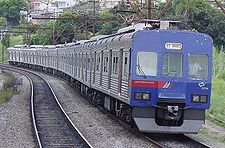
Cities with Metros
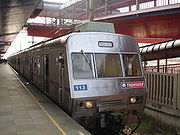
Tram
Brazil had a hundred tramway systems. Currently, there are vintage tramways operating in Belém, Campinas, Campos de Jordao, Itatinga, Rio de Janeiro and Santos.
connecting São Paulo
and Rio de Janeiro
is currently under development. The high-speed line is not expected to be operational in time for the 2014 FIFA World Cup
.
Highway
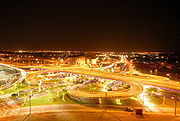
Brazil has 1,751,868 kilometers of roads, 96,353 km of them paved and 1,655,515 km unpaved. That means that only 5.5% of the roads are paved and that 94.5% are unpaved. The most important highway of the country is the BR-101
, which crosses 12 states.
The country has a low rate of car ownership of 140 per 1000 population, however in comparison to the other developing economies of the BRIC
group Brazil exceeds India and China.
Waterway
50,000 km navigable (most in areas remote from industry or population) (2008)
Pipelines
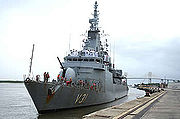
Paraguay River
136 ships ( or over) totaling /
ships by type: (1999 est.)
Airport
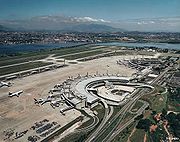 Most international flights must go to Guarulhos International Airport
Most international flights must go to Guarulhos International Airport
in São Paulo or Galeão International Airport in Rio de Janeiro. Belo Horizonte is the main international airport outside Rio de Janeiro and São Paulo. A few go to Brasilia, Recife, Natal, and just recently Fortaleza has accepted international flights. With South American integration, more airports can be expected to open to international flights.
734
over 3,047 m:
7
2,438 to 3,047 m:
26
1,524 to 2,437 m:
169
914 to 1,523 m:
476
under 914 m:
56 (2008)
3,442
1,524 to 2,437 m:
85
914 to 1,523 m:
1,541
under 914 m:
1,816 (2008)
National airline
RailwaysRail transportRail transport is a means of conveyance of passengers and goods by way of wheeled vehicles running on rail tracks. In contrast to road transport, where vehicles merely run on a prepared surface, rail vehicles are also directionally guided by the tracks they run on...

- Total actual network: 29,295 km
- Broad gaugeBroad gaugeBroad-gauge railways use a track gauge greater than the standard gauge of .- List :For list see: List of broad gauges, by gauge and country- History :...
: 4,932 km gauge (939 km electrified) - Narrow gauge: 23,773 km gauge (581 km electrified)
- Dual gaugeDual gaugeA dual-gauge or mixed-gauge railway has railway track that allows trains of different gauges to use the same track. Generally, a dual-gauge railway consists of three rails, rather than the standard two rails. The two outer rails give the wider gauge, while one of the outer rails and the inner rail...
: 396 km 1000 mm and 1600 mm gauges (three rails) - Standard gaugeStandard gaugeThe standard gauge is a widely-used track gauge . Approximately 60% of the world's existing railway lines are built to this gauge...
: 194 km gauge: (2006)
- Estrada de Ferro do Amapá in the middle of the Amazon RainforestAmazon RainforestThe Amazon Rainforest , also known in English as Amazonia or the Amazon Jungle, is a moist broadleaf forest that covers most of the Amazon Basin of South America...
also used standard gauge. - A 12 km section of the former gauge Estrada de Ferro Oeste de MinasEstrada de Ferro Oeste de MinasThe Estrada de Ferro Oeste de Minas was a narrow gauge railway located in the southeastern Brazilian state of Minas Gerais. At its peak the railway's route totalled...
is retained as a heritage railwayHeritage railwaythumb|right|the Historical [[Khyber train safari|Khyber Railway]] goes through the [[Khyber Pass]], [[Pakistan]]A heritage railway , preserved railway , tourist railway , or tourist railroad is a railway that is run as a tourist attraction, in some cases by volunteers, and...
.
Cities with MetrosRapid transitA rapid transit, underground, subway, elevated railway, metro or metropolitan railway system is an electric passenger railway in an urban area with a high capacity and frequency, and grade separation from other traffic. Rapid transit systems are typically located either in underground tunnels or on...

|
Recife Recife is the fifth-largest metropolitan area in Brazil with 4,136,506 inhabitants, the largest metropolitan area of the North/Northeast Regions, the 5th-largest metropolitan influence area in Brazil, and the capital and largest city of the state of Pernambuco. The population of the city proper... Rio de Janeiro Rio de Janeiro , commonly referred to simply as Rio, is the capital city of the State of Rio de Janeiro, the second largest city of Brazil, and the third largest metropolitan area and agglomeration in South America, boasting approximately 6.3 million people within the city proper, making it the 6th... São Paulo São Paulo is the largest city in Brazil, the largest city in the southern hemisphere and South America, and the world's seventh largest city by population. The metropolis is anchor to the São Paulo metropolitan area, ranked as the second-most populous metropolitan area in the Americas and among... Salvador, Bahia Salvador is the largest city on the northeast coast of Brazil and the capital of the Northeastern Brazilian state of Bahia. Salvador is also known as Brazil's capital of happiness due to its easygoing population and countless popular outdoor parties, including its street carnival. The first... (Under construction) Teresina Teresina is the capital and most populous municipality in the Brazilian state of Piauí. It is located in North-central Piauí 366 km from the coast.It is therefore, the only capital in the Northeast that is not located on the shores of the Atlantic Ocean. With 814 439 inhabitants, it is the 19th... |
Railway links with adjacent countries
| Uruguay Transport in Uruguay Transport in nation of Uruguay consists of 2,835 km of rail network, 8,983 km of roads, 1,600 km of navigable waterways, and 15 airports/landing fields serviced by the national airline PLUNA.-Railways:total:2835.558 km... - yes - break-of-gauge Break-of-gauge With railways, a break-of-gauge occurs where a line of one gauge meets a line of a different gauge. Trains and rolling stock cannot run through without some form of conversion between gauges, and freight and passengers must otherwise be transloaded... (Brazil) / (Uruguay) Argentina - yes - break-of-gauge Break-of-gauge With railways, a break-of-gauge occurs where a line of one gauge meets a line of a different gauge. Trains and rolling stock cannot run through without some form of conversion between gauges, and freight and passengers must otherwise be transloaded... (Brazil)/ (Argentina) Paraguay - no Bolivia - yes - gauge both countries |
Peru - no Colombia Transport in Colombia Transport in Colombia is regulated by the Ministry of Transport.Road travel is the main means of transport; almost 70 percent of cargo is transported by road, as compared with 27 percent by railroad, 3 percent by internal waterways, and 1 percent by air. Nevertheless, Colombia has one of the lowest... - no Venezuela - no Guyana Transport in Guyana The transport sector comprises the physical facilities, terminals, fleets and ancillary equipment of all the various modes of transport operating in Guyana, the transport services, transport agencies providing these services, the organizations and people who plan, build, maintain, and operate the... - no Suriname Transport in Suriname The South American country of Suriname has a number of forms of transport.-Railways:*Railways, total: 166 km single track.**standard gauge: 80 km gauge in West-Suriname, but not in use... - no French Guiana Transport in French Guiana -Railways:A short railway is used within the Guiana Space Centre. There are no other railways in Guiana, and no connections to neighbouring countries.-Highways:total:1,817 kmpaved:727 kmunpaved:1,090 km -Waterways:... - no |
TramTramA tram is a passenger rail vehicle which runs on tracks along public urban streets and also sometimes on separate rights of way. It may also run between cities and/or towns , and/or partially grade separated even in the cities...
ways (Street Railways)
Brazil had a hundred tramway systems. Currently, there are vintage tramways operating in Belém, Campinas, Campos de Jordao, Itatinga, Rio de Janeiro and Santos.High-speed rail
A high-speed railHigh-speed rail
High-speed rail is a type of passenger rail transport that operates significantly faster than the normal speed of rail traffic. Specific definitions by the European Union include for upgraded track and or faster for new track, whilst in the United States, the U.S...
connecting São Paulo
São Paulo
São Paulo is the largest city in Brazil, the largest city in the southern hemisphere and South America, and the world's seventh largest city by population. The metropolis is anchor to the São Paulo metropolitan area, ranked as the second-most populous metropolitan area in the Americas and among...
and Rio de Janeiro
Rio de Janeiro
Rio de Janeiro , commonly referred to simply as Rio, is the capital city of the State of Rio de Janeiro, the second largest city of Brazil, and the third largest metropolitan area and agglomeration in South America, boasting approximately 6.3 million people within the city proper, making it the 6th...
is currently under development. The high-speed line is not expected to be operational in time for the 2014 FIFA World Cup
2014 FIFA World Cup
The 2014 FIFA World Cup will be the 20th FIFA World Cup, an international association football tournament that will take place in Brazil from 12 June to 13 July 2014....
.
HighwayHighwayA highway is any public road. In American English, the term is common and almost always designates major roads. In British English, the term designates any road open to the public. Any interconnected set of highways can be variously referred to as a "highway system", a "highway network", or a...
s

Brazil has 1,751,868 kilometers of roads, 96,353 km of them paved and 1,655,515 km unpaved. That means that only 5.5% of the roads are paved and that 94.5% are unpaved. The most important highway of the country is the BR-101
BR-101
The BR-101 is a longitudinal highway of Brazil. It is the longest in the country with a length of nearly , and it is also considered the most important....
, which crosses 12 states.
The country has a low rate of car ownership of 140 per 1000 population, however in comparison to the other developing economies of the BRIC
BRIC
In economics, BRIC is a grouping acronym that refers to the countries of Brazil, Russia, India and China, which are all deemed to be at a similar stage of newly advanced economic development...
group Brazil exceeds India and China.
WaterwayWaterwayA waterway is any navigable body of water. Waterways can include rivers, lakes, seas, oceans, and canals. In order for a waterway to be navigable, it must meet several criteria:...
s
50,000 km navigable (most in areas remote from industry or population) (2008) PipelinesPipeline transportPipeline transport is the transportation of goods through a pipe. Most commonly, liquids and gases are sent, but pneumatic tubes that transport solid capsules using compressed air are also used....
- condensateCondensateCondensate may refer to:* The liquid phase produced by the condensation of steam or any other gas* The product of a chemical condensation reaction, other than water* Natural gas condensate, in the natural gas industry- Quantum physics :...
/gas 62 km - natural gasNatural gasNatural gas is a naturally occurring gas mixture consisting primarily of methane, typically with 0–20% higher hydrocarbons . It is found associated with other hydrocarbon fuel, in coal beds, as methane clathrates, and is an important fuel source and a major feedstock for fertilizers.Most natural...
9,892 km - liquid petroleum gas 353 km
- crude oil 4,517 km
- refined products 4,465 km (2008)
Atlantic Ocean

|
Recife Recife is the fifth-largest metropolitan area in Brazil with 4,136,506 inhabitants, the largest metropolitan area of the North/Northeast Regions, the 5th-largest metropolitan influence area in Brazil, and the capital and largest city of the state of Pernambuco. The population of the city proper... Rio de Janeiro Rio de Janeiro , commonly referred to simply as Rio, is the capital city of the State of Rio de Janeiro, the second largest city of Brazil, and the third largest metropolitan area and agglomeration in South America, boasting approximately 6.3 million people within the city proper, making it the 6th... Rio Grande, Rio Grande do Sul Rio Grande is the oldest city in the Brazilian state of Rio Grande do Sul and also the former state capital from 1835 to 1845... Santos (São Paulo) -Sister cities: Shimonoseki, Japan Nagasaki, Japan Funchal, Portugal Trieste, Italy Coimbra, Portugal Ansião, Portugal Arouca, Portugal Ushuaia, Argentina Havana, Cuba Taizhou. China Ningbo. China Constanţa, Romania Ulsan, South Korea Colón, Panama* Cadiz, Spain... |
São Francisco do Sul São Francisco do Sul is a municipality in the Brazilian state of Santa Catarina. It covers an area of 493 km² and had an estimated population of 37,725 in 2005.. It was founded as a village by the Portuguese in 1658... São Sebastião, São Paulo São Sebastião is a Brazilian city, located on the southeast coast of Brazil, in the state of São Paulo. The population in 2006 is 75,886, its density is 188.1/km² and the area is 403 km². The Tropic of Capricorn lies 25 km north... Itajaí Itajaí is a Brazilian city in the state of Santa Catarina.-History:The city was founded on June 15, 1860, but the colonization of Itajaí started in 1658, when the Paulista João Dias D’Arzão arrived in the region. In 1750, Portuguese colonists coming from Madeira and the Azores made this region... |
Paraguay RiverParaguay RiverThe Paraguay River is a major river in south central South America, running through Brazil, Bolivia, Paraguay, and Argentina...
(international water wayInternational watersThe terms international waters or trans-boundary waters apply where any of the following types of bodies of water transcend international boundaries: oceans, large marine ecosystems, enclosed or semi-enclosed regional seas and estuaries, rivers, lakes, groundwater systems , and wetlands.Oceans,...
)
Merchant marine
total:136 ships ( or over) totaling /
ships by type: (1999 est.)
|
Passenger ship A passenger ship is a ship whose primary function is to carry passengers. The category does not include cargo vessels which have accommodations for limited numbers of passengers, such as the ubiquitous twelve-passenger freighters once common on the seas in which the transport of passengers is... 12 |
AirportAirportAn airport is a location where aircraft such as fixed-wing aircraft, helicopters, and blimps take off and land. Aircraft may be stored or maintained at an airport...
s

Guarulhos International Airport
São Paulo/Guarulhos – Governador André Franco Montoro International Airport , formerly called Cumbica Airport after the district where it is located and the Air Force Base that still exists at the airport complex, is the main airport serving São Paulo, Brazil. It is located in the adjoining...
in São Paulo or Galeão International Airport in Rio de Janeiro. Belo Horizonte is the main international airport outside Rio de Janeiro and São Paulo. A few go to Brasilia, Recife, Natal, and just recently Fortaleza has accepted international flights. With South American integration, more airports can be expected to open to international flights.
Airports - with paved runways
total:734
over 3,047 m:
7
2,438 to 3,047 m:
26
1,524 to 2,437 m:
169
914 to 1,523 m:
476
under 914 m:
56 (2008)
Airports - with unpaved runways
total:3,442
1,524 to 2,437 m:
85
914 to 1,523 m:
1,541
under 914 m:
1,816 (2008)
National airlineAirlineAn airline provides air transport services for traveling passengers and freight. Airlines lease or own their aircraft with which to supply these services and may form partnerships or alliances with other airlines for mutual benefit...
s
- Azul Linhas Aéreas Brasileiras
- Gol Transportes AéreosGol Transportes AéreosGol Transportes Aéreos is a Brazilian airline based in Comandante Lineu Gomes Square, São Paulo City, Brazil....
- OceanAirOceanAirAvianca Brazil , trademark of Oceanair Linhas Aéreas S/A, is a Brazilian airline based in São Paulo, Brazil. It operates passenger services from 23 destinations. Its main base is Guarulhos International Airport, São Paulo. Even though the legal name of the airline remains OceanAir, Avianca ...
- PantanalPantanalThe Pantanal is a tropical wetland and one of the world's largest wetland of any kind. Most of it lies within the Brazilian state of Mato Grosso do Sul, but it extends into Mato Grosso and portions of Bolivia and Paraguay, sprawling over an area estimated at between and...
- TAM Airlines (TAM Linhas Aéreas)
- VarigVarigVARIG was the first airline founded in Brazil, in 1927. From 1965 until 1990 it was Brazil's leading and almost only international airline...
- Total Linhas AéreasTotal Linhas AereasTotal Linhas Aéreas is an airline based in Belo Horizonte, Minas Gerais, Brazil. It operates regional passenger and cargo charter and air taxi services, as well as night mail flights on behalf of the Brazilian post.-History:...
- Air MinasAir MinasAir Minas Linhas Aéreas was an airline based in Belo Horizonte, Minas Gerais, Brazil. It operated passenger services from Belo Horizonte to destinations in the states of Minas Gerais and São Paulo. The airline was grounded on May 30, 2010 and lost its operational license on September 20,...
- WebjetWebjetWebjet Limited is an Australian online travel booking website selling flights, hotel bookings and car hires. Webjet operates in Australia, New Zealand, North America, Singapore and Hong Kong....

